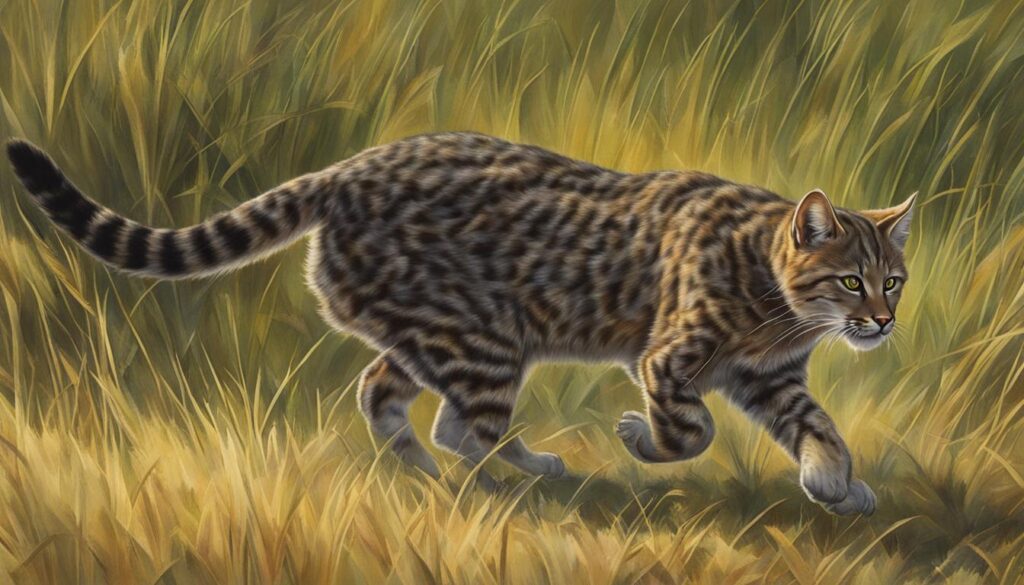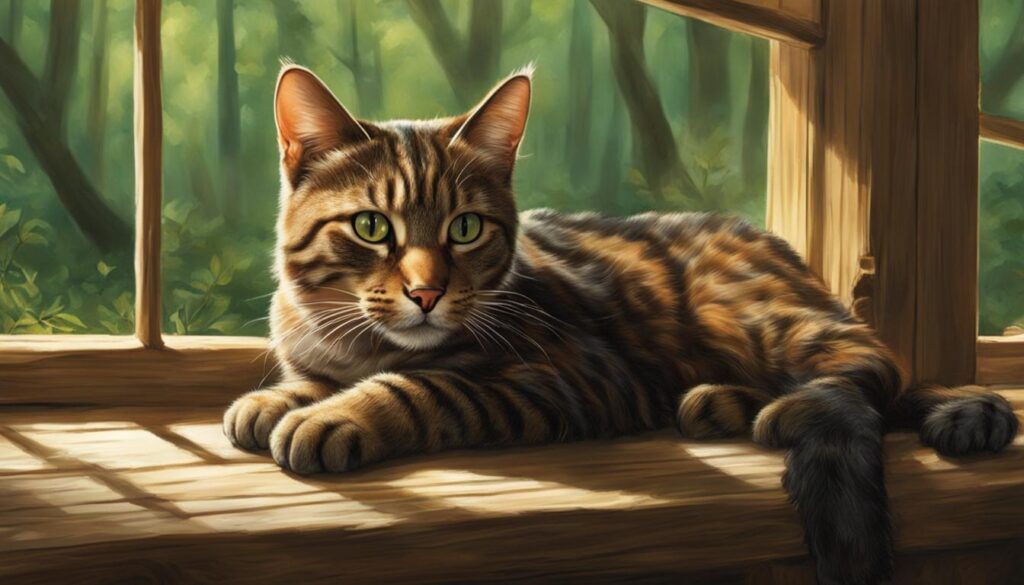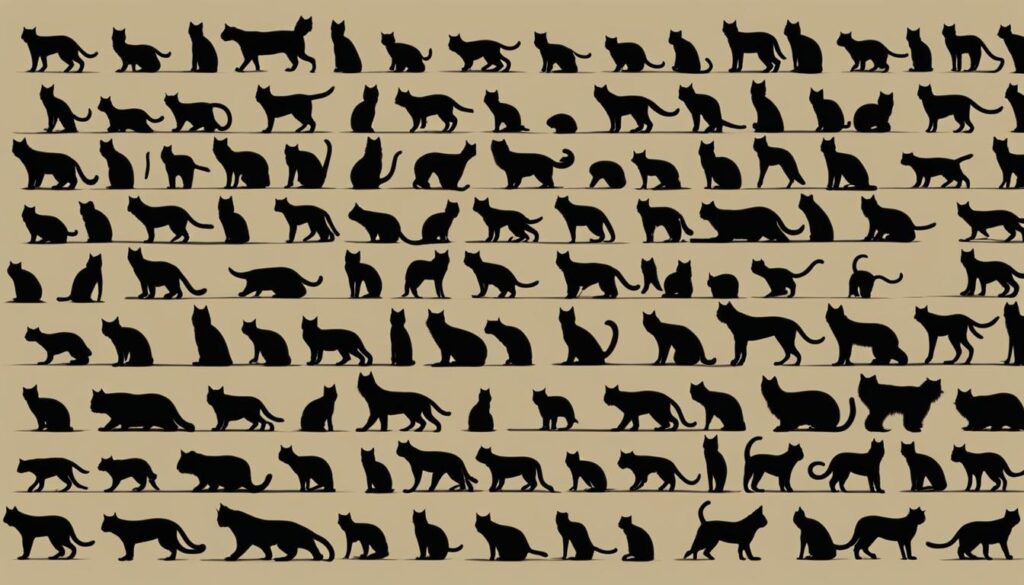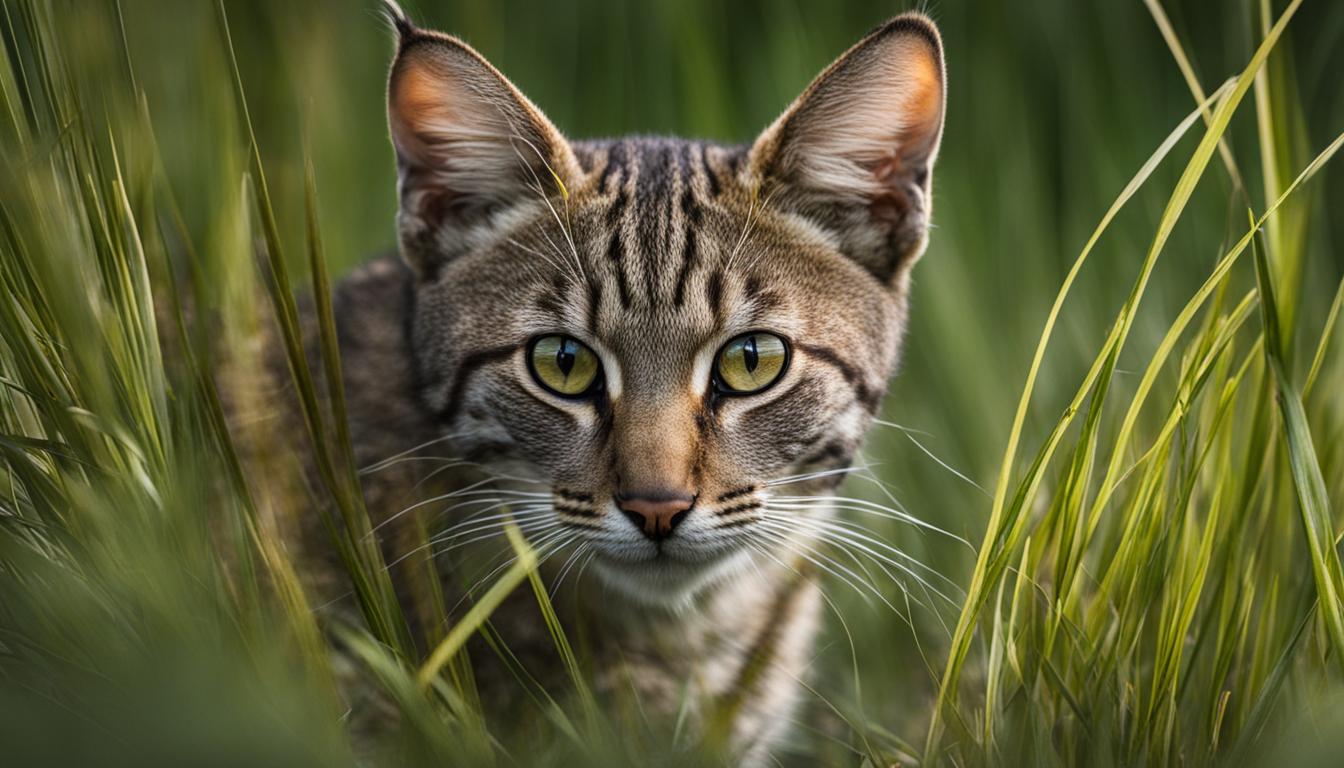The Evolution of Cats: From Wild Predators to Beloved Pets
Welcome to our exploration of the fascinating journey of cat evolution, from their origins as wild predators to becoming our beloved pets. Join us as we delve into the domestication process, uncovering the feline evolutionary history and the fascinating traits that make cats unique companions.
Key Takeaways
- Cats began living with humans around 9,000 years ago during the rise of farming and the Neolithic period.
- The domestication of cats from their wild ancestors, such as the Near Eastern wildcat, took thousands of years.
- The rise of agriculture played a significant role in establishing the human-cat relationship.
- The genetic and archaeological evidence suggests that the domestic cat descended from the African wildcat.
- Despite minimal genetic changes, domestic cats have developed social behaviors and communication strategies to interact effectively with humans.
Join us on this journey as we uncover the mysteries behind the evolution of our feline friends and deepen our understanding of their unique place in our lives.
The Importance of Agriculture in Cat Domestication
The rise of agriculture in the Neolithic period had a significant impact on the domestication of cats. The establishment of crop fields and the use of animal feces as fertilizer led to a dramatic increase in heavy nitrogen isotope in soils. This change in nitrogen isotope ratio was recorded in the bones of ancient cats, indicating that they preyed in manured fields and had heavy nitrogen-rich diets.
Further analysis revealed that Neolithic cats primarily hunted synanthropic animals, which lived close to humans and relied on manured crops for their survival. This suggests that the availability of prey in agricultural landscapes played a crucial role in the domestication of cats.
Feline Genealogy and Natural Selection
“Through the process of natural selection, wildcats that displayed traits suited to living in and around agricultural areas had a higher likelihood of survival and passing on their genetic traits. Over time, these traits were selectively favored and became more prevalent in the domestic cat population.”
As agricultural practices advanced, cats continued to adapt to living in close proximity to humans and their agricultural activities. The relationship between cats and humans became mutually beneficial, with cats controlling rodents and other pests that threatened stored crops.
To illustrate the impact of agriculture on cat domestication, the table below provides a comparison of ancient cat species and their hunting behaviors in different environments:
| Ancient Cat Species | Habitat | Hunting Behavior |
|---|---|---|
| Felis chaus | Wetlands and marshes | Hunts birds, small mammals, and amphibians |
| Felis libyca | Grasslands and open areas | Hunts small mammals, birds, and reptiles |
| Felis silvestris lybica | Forest and woodland | Hunts small mammals, birds, and insects |
These ancient cat species inhabited various environments, each with its specific hunting preferences. However, the domestication process favored those cats that adapted to living near agricultural areas due to the consistent availability of prey and favorable hunting conditions.

The image above visually represents the evolution of cats and the impact of agriculture on their domestication.
By understanding the importance of agriculture in cat domestication, we gain insight into the intricate relationship between humans and cats throughout history. The role of agriculture in providing a consistent food source and attracting cats to human settlements has shaped the evolution of our feline companions.
The Ancestral Origins of Domestic Cats
Genetic and archaeological discoveries have revealed fascinating insights into the ancestral origins of domestic cats. These beloved pets trace their lineage back to the African wildcat, specifically the North African subspecies known as Felis silvestris lybica. Through a process of natural selection, this wildcat population in the Middle East played a crucial role in the evolution of domestic cats.
The early settlements in the Fertile Crescent, established around 10,000 years ago, provided a new environment for wildcats to exploit. It was during this time that humans transitioned from a hunter-gatherer society to an agricultural one. The presence of house mice and readily available food sources in human settlements likely attracted wildcats, leading to a mutually beneficial relationship.
Cats that displayed greater tolerance for living in human-dominated environments had a higher chance of survival and reproduction. Over generations, these adaptable cats passed on their genes, leading to the gradual domestication of the species. While the exact process and timeline of domestication are still being studied, the influence of human settlements on cat evolution is undeniable.

| Cat Evolution Milestones | Timeline |
|---|---|
| Wildcats in the Middle East adapt to living near human settlements | Around 10,000 years ago |
| Cats prey on house mice attracted to human settlements | Around 9,000 years ago |
| Selective breeding by humans for desirable traits | Over thousands of years |
| Domesticated cats become companions and pest controllers | Present day |
Throughout this evolutionary journey, cats retained their predatory behavior. Although domesticated, they still exhibit the chasing and hunting instincts that their wild ancestors relied on for survival. This predatory behavior can be seen in various aspects of a domestic cat’s life, from playtime activities to their exceptional hunting skills when faced with rodents or insects.
Understanding the ancestral origins of domestic cats provides valuable insights into their evolutionary history and nature. It highlights the unique relationship between cats and humans that has developed over thousands of years, resulting in the loving and cherished companions that bring joy to our lives today.
The Evolutionary Changes in Domestic Cats
The domestication process of cats resulted in only minor evolutionary changes compared to other domesticated animals. Genetic analysis has shown that only 13 genes have been changed by natural selection during the domestication of cats, while almost three times as many genes changed during the domestication of dogs.
Despite these minimal genetic changes, the most significant evolutionary changes in domestic cats have been in their behavior. Cats, known for their solitary hunting nature, have developed social behaviors similar to those observed in lion prides when living in groups with abundant food provided by humans.
They form social groups, groom each other, and communicate through tail movements and vocalizations. This social behavior is a stark contrast to their wild ancestors, highlighting the adaptability and flexibility of domesticated cats.

Cats have also evolved unique ways of communicating with humans. They have learned to use specific meows and purring patterns to convey different messages, such as expressing hunger, seeking attention, or marking territory. This ability to communicate effectively with humans has strengthened the bond between cats and their human companions.
Conclusion
The evolution of cats from wild predators to beloved pets has been a fascinating journey. As the rise of agriculture and the establishment of human settlements shaped our world, cats found their place alongside us. Their remarkable adaptability and hunting instincts played a crucial role in their domestication.
Despite minimal genetic changes, domestic cats have undergone significant behavioral transformations. They have developed social behaviors resembling that of lion prides and have found unique ways to communicate with their human companions. Through tail movements, vocalizations, and distinct purring patterns, cats have mastered the art of connecting with us.
Understanding the evolutionary history of cats deepens our appreciation for these incredible creatures. It highlights their ability to thrive in diverse environments and their inherent predator instincts that coexist with their lovable and companionable nature. These remarkable beings have truly become an integral part of our lives, bringing joy and companionship to households around the world.
FAQ
How long have cats been domesticated?
Cats began living with humans around 9,000 years ago during the rise of farming and the Neolithic period.
What triggered the domestication of cats?
The exact process of how cats evolved into beloved pets is still unknown, but recent studies suggest that the rise of agriculture played a significant role in establishing the human-cat relationship.
What evidence supports the connection between agriculture and cat domestication?
Analysis of archeological remains from Neolithic times in Poland revealed that early cats preyed in manured fields, indicating that agriculture may have triggered the domestication of wildcats.
What did cats prey on in agricultural landscapes?
Neolithic cats primarily hunted synanthropic animals, which lived close to humans and relied on manured crops for their survival.
Where did domestic cats descend from?
Genetic and archaeological discoveries have revealed that the domestic cat descended from the African wildcat, specifically the North African subspecies known as Felis silvestris lybica.
How did cats adapt to living in human-dominated environments?
Cats that were more tolerant of living in human-dominated environments thrived and passed on their genes, leading to the domestication of cats over time.
What are the most significant evolutionary changes in domestic cats?
The most significant evolutionary changes in domestic cats have been in their behavior. Despite their solitary hunting nature, domestic cats have developed social behaviors similar to lion prides when living in groups with abundant food provided by humans.
How do domestic cats communicate with humans?
Cats have evolved to communicate more effectively with humans, using specific meows and purring patterns to convey different messages.
What has been the impact of the domestication of cats?
Understanding the evolutionary history of cats enhances our appreciation for these fascinating and beloved companions.


